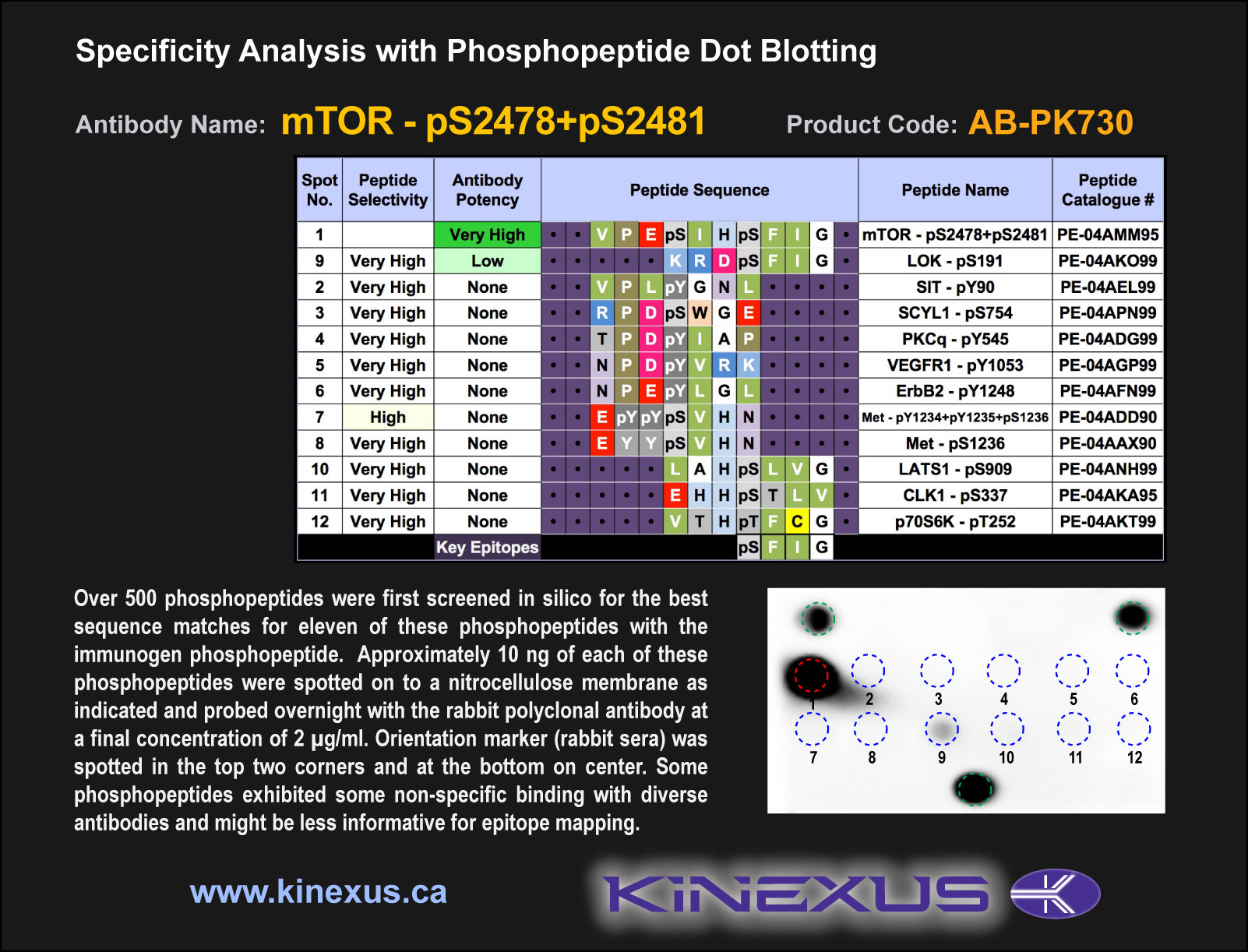Product Name: mTOR-pS2478+pS2481
Product Number: AB-PK730
| Size: | 25 µg | Price: | 89.00 | |
| $US |
Target Full Name: Mammalian target of rapamycin (FRAP); FKBP12-rapamycin complex-associated protein
Target Alias: DJ576K7.1; FK506 binding protein 12-rapamycin associated protein 1; FK506 binding protein 12-rapamycin associated protein 2; FK506-binding protein 12-rapamycin complex-associated protein 1; FKBP12-rapamycin complex-associated protein 1; FKBP-rapamycin associated protein; FLJ44809; FRAP; FRAP2; RAPT1; mTOR; CCDS127.1; ENSG00000198793
Product Type Specific: Protein kinase phosphosite-specific antibody
Antibody Code: PK730
Antibody Target Type: Phosphosite-specific
Antibody Phosphosite: S2478+S2481
Protein UniProt: P42345
Protein SigNET: P42345
Target Alias: DJ576K7.1; FK506 binding protein 12-rapamycin associated protein 1; FK506 binding protein 12-rapamycin associated protein 2; FK506-binding protein 12-rapamycin complex-associated protein 1; FKBP12-rapamycin complex-associated protein 1; FKBP-rapamycin associated protein; FLJ44809; FRAP; FRAP2; RAPT1; mTOR; CCDS127.1; ENSG00000198793
Product Type Specific: Protein kinase phosphosite-specific antibody
Antibody Code: PK730
Antibody Target Type: Phosphosite-specific
Antibody Phosphosite: S2478+S2481
Protein UniProt: P42345
Protein SigNET: P42345
Antibody Type: Polyclonal
Antibody Host Species: Rabbit
Antibody Immunogen Source: Human mTOR (FRAP) sequence peptide Cat. No.: PE-04AMM95
Antibody Immunogen Sequence: VPE(pS)IH(pS)FIG(bA)C
Antibody Immunogen Description: Corresponds to amino acid residues V2475 to G2484; In the C-terminal fifth of the kinase at the end of the PI3_PI4-kinase domain.
Antibody Host Species: Rabbit
Antibody Immunogen Source: Human mTOR (FRAP) sequence peptide Cat. No.: PE-04AMM95
Antibody Immunogen Sequence: VPE(pS)IH(pS)FIG(bA)C
Antibody Immunogen Description: Corresponds to amino acid residues V2475 to G2484; In the C-terminal fifth of the kinase at the end of the PI3_PI4-kinase domain.
Production Method: The immunizing peptide was produced by solid phase synthesis on a multipep peptide synthesizer and purified by reverse-phase hplc chromatography. Purity was assessed by analytical hplc and the amino acid sequence confirmed by mass spectrometry analysis. This peptide was coupled to KLH prior to immunization into rabbits. New Zealand White rabbits were subcutaneously injected with KLH-coupled immunizing peptide every 4 weeks for 4 months. The sera from these animals was applied onto an agarose column to which the immunogen peptide was thio-linked. Antibody was eluted from the column with 0.1 M glycine, pH 2.5. Subsequently, the antibody solution was neutralized to pH 7.0 with saturated Tris.This antibody was also subject to negative purification over phosphotyrosine-agarose.
Antibody Modification: Unconjugated. Contact KInexus if you are interest in having the antibody biotinylated or coupled with fluorescent dyes.
Antibody Modification: Unconjugated. Contact KInexus if you are interest in having the antibody biotinylated or coupled with fluorescent dyes.
Antibody Concentration: 0.75 mg/ml
Storage Buffer: Phosphate buffered saline pH 7.4, 0.05% Thimerasol
Storage Conditions: For long term storage, keep frozen at -40°C or lower. Stock solution can be kept at +4°C for more than 3 months. Avoid repeated freeze-thaw cycles.
Product Use: Western blotting | Antibody microarray
Antibody Dilution Recommended: 2 µg/ml for immunoblotting
Antibody Potency: Very strong immunoreactivity with immunogen peptide on dot blots.
Antibody Species Reactivity: Human
Antibody Positive Control: The observed molecular mass of the processed target protein on SDS-PAGE gels is reported to be around 250-300 kDa.
Storage Buffer: Phosphate buffered saline pH 7.4, 0.05% Thimerasol
Storage Conditions: For long term storage, keep frozen at -40°C or lower. Stock solution can be kept at +4°C for more than 3 months. Avoid repeated freeze-thaw cycles.
Product Use: Western blotting | Antibody microarray
Antibody Dilution Recommended: 2 µg/ml for immunoblotting
Antibody Potency: Very strong immunoreactivity with immunogen peptide on dot blots.
Antibody Species Reactivity: Human
Antibody Positive Control: The observed molecular mass of the processed target protein on SDS-PAGE gels is reported to be around 250-300 kDa.
Antibody Specificity: Very high
Antibody Cross Reactivity: No significant cross-reactive proteins detected in MCF7 and T98G cells.
Related Product 1: mTOR-pS2478+pS2481 blocking peptide
Related Product 2: mTOR pan-specific antibody (Cat. No.: AB-NK116-2)
Related Product 3: mTOR-3 pan-specific antibody (Cat. No.: AB-NK116-3)
Related Product 4: mTOR pan-specific antibody (Cat. No.: AB-NK116-3P)
Related Product 5: mTOR-2 pan-specific antibody (Cat. No.: AB-NK116-4)
Related Product 6: mTOR-1 pan-specific antibody (Cat. No.: AB-NK116-5)
Related Product 7: mTOR-pS2448 phosphosite-specific antibody (Cat. No.: AB-PK729)
Antibody Cross Reactivity: No significant cross-reactive proteins detected in MCF7 and T98G cells.
Related Product 1: mTOR-pS2478+pS2481 blocking peptide
Related Product 2: mTOR pan-specific antibody (Cat. No.: AB-NK116-2)
Related Product 3: mTOR-3 pan-specific antibody (Cat. No.: AB-NK116-3)
Related Product 4: mTOR pan-specific antibody (Cat. No.: AB-NK116-3P)
Related Product 5: mTOR-2 pan-specific antibody (Cat. No.: AB-NK116-4)
Related Product 6: mTOR-1 pan-specific antibody (Cat. No.: AB-NK116-5)
Related Product 7: mTOR-pS2448 phosphosite-specific antibody (Cat. No.: AB-PK729)
Scientific Background: mTOR (FRAP1) is a protein-serine/threonine kinase of the Atypical group and PIKK family. It mediates cell growth, metabolism, and survival. It regulates various cellular pathways such as insulin signalling, eIF4e and p70S6 kinase activation for protein synthesis, HIFa, VEGF, nutrient and hormone signals, ribosome biogenesis, regulation of cell cycle progression, angiogenesis, cell polarity and cytokeleton reorganization. Phosphorylation of S2448 and S2481 increases its phosphotransferase activity, and it is stimulated by RHEBm. Phosphorylation of T2446 inhibits phosphorylation of the S2448 activatory site. It is also negatively regulated by DEPDC6. Dysregulation in signalling that leads to constant activation of mTOR lead to uncontrolled proliferation and cell cycle progression and oncogensis. Increased invasiveness has also be shown do be associated with mTOR activity. While it features a wide range of mutations, this might reflect the very large size of the protein rather than its identification as a tumour suppressor protein. Cancer-related mutations for mTOR in human tumours point to a gain of function of the protein kinase, indicating that it might function as an oncoprotein (OP). The active form of the protein kinase normally acts to promote tumour cell proliferation. mTOR has been linked with Tuberous Sclerosis, Subependymal Giant Cell Astrocytoma (SEGA), Lymphangioleiomyomatosis (LAM), Tuberous Sclerosis Complex, Plasmablastic Lymphoma (PBL), Ewing's tumours, and Kidney Angiomyolipoma.
Figure 1. Epitope mapping of mTOR-pS2478+pS2481 antibody with similar phosphopeptides on dot blots.
Figure 2. Identification of phosphosites related to mTOR-pS2478+pS2481.
© Kinexus Bioinformatics Corporation 2017



